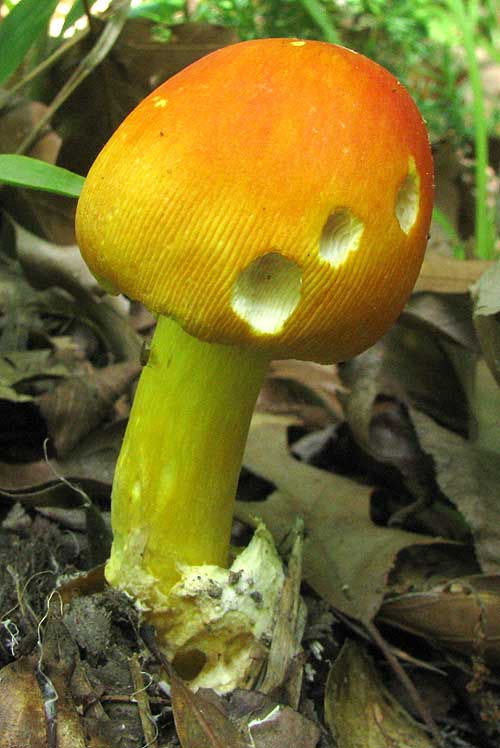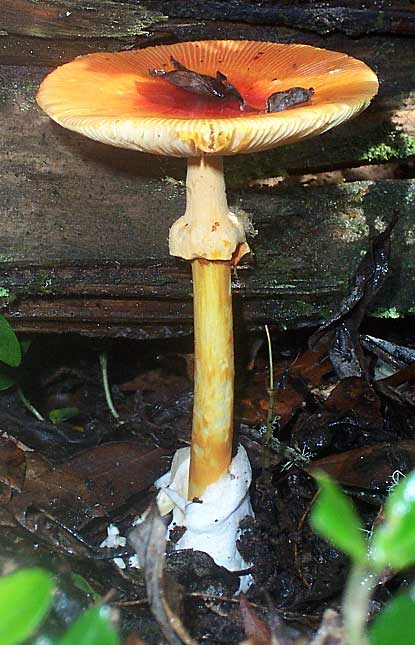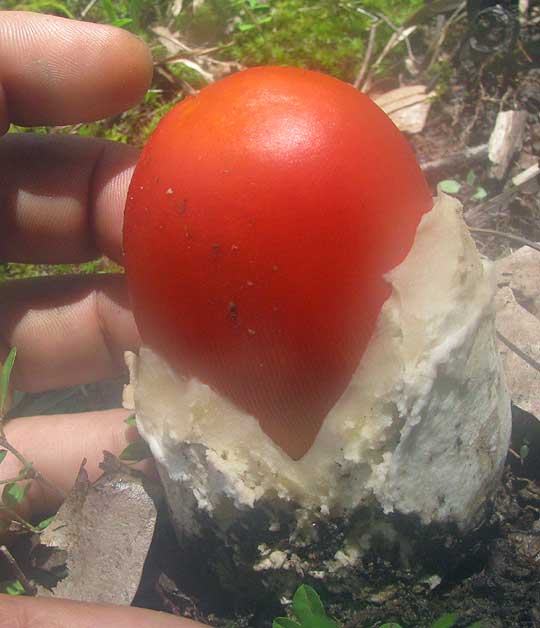Excerpts from Jim Conrad's
Naturalist Newsletter
from the April 22, 2012 Newsletter issued from the woods of the Loess Hill Region a few miles east of Natchez, Mississippi, USA
"CAESAR'S MUSHROOMS" UP

Above you see a pretty little mushroom that popped up a couple of days after a rain this week. It's the "Caesar's Mushroom," "AMANITA JACKSONII." Both the English name and binomial are within quotation marks because it's not really the Caesar's Mushroom, which is European, and it's not really Amanita caesarea, for the same reason. But, the taxonomy of this group of fungi is in a big mess, and there aren't any better names. The whole thing is entertainingly explained by Tom Volk at http://botit.botany.wisc.edu/toms_fungi/mar2002.html.
The various "Caesar's Mushrooms" are famous for being delicious. During my hermit days near here an acquaintance was familiar with the species and together we picked large numbers of them. They are about the best mushroom eating I've ever experienced.
But I don't pick and eat them on my own because the genus Amanita is famous for including some of the most deadly of mushrooms, including Death Angels, Destroying Angels or Death Caps, and the toxic and hallucinogenic Fly Agaric. Since Amanita taxonomy is so confusing and each geographic region has its own mix of species, I don't eat "Ceasar's" unless I have a local expert with me -- especially not after my famous mushroom poisoning in Kentucky in 2006. The page describing that embarrassing debacle naturally has become one of my most visited web pages. You can read about it at the bottom of the page at https://www.backyardnature.net/n/x/green-sp.htm.
from the August 3, 2007 Newsletter issued from Sierra Gorda Biosphere Reserve, QUERÉTARO, MÉXICO
MEXICO'S "CAESAR'S MUSHROOMS"
Of all poisonous mushrooms, members of the genus Amanita are the most deadly. Amanitas are responsible for 95% of all fatalities resulting from mushroom poisoning. With the rainy season's arrival mushrooms are popping up everywhere, and last week near El Madroño I saw two or three Amanita species, the most common and prettiest being the one shown below:

Despite the dire warnings I just gave about Amanitas, the Amanita in the picture is a "Caesar's Mushroom," and "Caesar's Mushrooms" have accounted for the best mushroom-eating I've ever enjoyed, back in Mississippi where during some seasons they were very common. "Caesar's Mushrooms," unlike most Amanitas, aren't the least poisonous.
I read that in Mexico we may have four or so mushroom species all looking like the one in my photograph and none the "real" Caesar's Mushroom, though that's what they've been called by English speakers. Whatever they're called*, since ancient times they've constituted an important part of indigenous Mexican cuisine. By the way, you should see the rainbow of mushrooms available in the huge Merced Market in Mexico City where Indians from all around bring their best finds to sell at the best prices.
Anyway, the only Amanitas I'm going to eat are those looking like our "Caesar's" and served by a local person who knows the local mushrooms, eats some himself, and who likes me.
By the way, the Amanita in my photograph is a "textbook mushroom" in that it displays so beautifully the important features of "gills" beneath the "cap," a "ring" around the stem, and the stem arising from a "cup." Most mushroom species display only one, two or none of these features. When you're identifying mushrooms it's always important to notice which, if any, of these features are present. More examples of rings and cups are shown on my mushroom identification page at https://www.backyardnature.net/f/mush-id.htm.
from the August 5, 2012 Newsletter issued from the woods of the Loess Hill Region a few miles east of Natchez, Mississippi, USA
MUSHROOM EMERGING FROM BUTTON STAGE
Mushrooms are a fungus's reproductive structure. The "working part" of a fungus consists of white, threadlike hyphae that spread through the soil or organic matter like much-branching tree roots. When conditions are right for reproduction the hyphae combine into egglike objects known as mushroom "buttons." At this stage you can cut across the button and see the future mushroom's cap and stem in cross section. The button's "shell" in which the future mushroom is protectively embedded is referred to as the "universal veil." When the mushroom emerges, it bursts through the veil. Sometimes parts of the veil stick to the mushroom's cap becoming distinctive patches or warts on the cap.
Sometimes the mushroom emerges from the button leading the button bottom surrounding the stem's base like a cup. This is what we see the emerging Caesar's Mushroom doing below:

There the mushroom's red cap emerges from its button. The bottom of the button now can be referred to as the mushroom's "volva." Some mushrooms have volvas but others don't. Its presence is an important feature to look for during mushroom identification. Caesar's Mushrooms have very well developed ones.